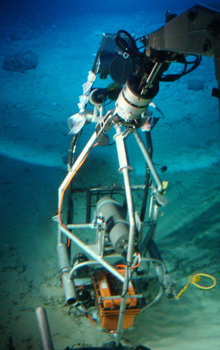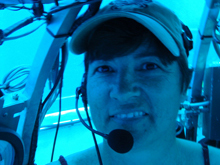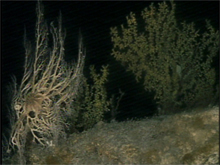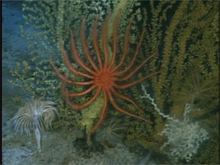
ORCA's Eye-in-the-Sea being deployed by the Johnson-Sea-Link submersible. Click image for larger view and image credit.
Secret Garden
July 21, 2009
Edith A. Widder, PhD
Expedition Chief Scientist
Ocean Research & Conservation Association
Ft. Pierce, Florida
![]() A Cuban dogfish shark attacks bait on the Eye-in-the-Sea camera system.
A Cuban dogfish shark attacks bait on the Eye-in-the-Sea camera system.
Our first dive was on a deep-water reef called a lithoherm. Shaped like an upside-down ship’s hull, the lithoherm ran hundreds of feet, north to south. We started out by placing the Ocean Research & Conservation Association (ORCA) Eye-in-the-Sea on a flat spot near the base of the reef. As soon as the camera hit bottom, Cuban dogfish sharks darted in and began ripping the bait. This promises to be an exciting deployment given what a rich area it is.
From there we proceeded up slope and south along the ridge top where we first encountered rows and rows of stalked crinoids (sea lilies), looking for all the world like they had been planted by some tipsy farmer. Further along, at the south end of the lithoherm, a different crop loomed into view — giant fan-like "trees" of magnificent golden coral, ranging in color from canary yellow to rust orange and auburn brown. Lurking in their branches were long-armed orange crabs with small white claws along with large, multi-armed orange sea stars, feather stars, and hydroids. Beneath the trees was an understory of little yellow feather stars, small white gorgonia, and an occasional patch of delicate white branching coral.

Chief Scientist Edie Widder in the Johnson-Sea-Link at 10-meter (33-foot) depth. Click image for larger view and image credit.
It is a wondrous garden, not just because of its diversity, but because of its age. Golden corals this large may be more than a thousand years old. It’s incredible to think this garden may have been here during the Dark Ages. And it’s even more incredible to think it could be wiped out in the blink of an eye. Destructive fishing practices such as bottom trawling scrape the bottom raw for a single haul of seafood. It’s long term destruction for short term gain. I have no idea how long it would take for this magnificent secret garden to regrow. Far better that it remain a secret place to be explored, studied, and cherished for generations to come.






















